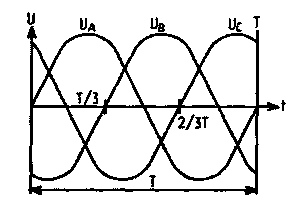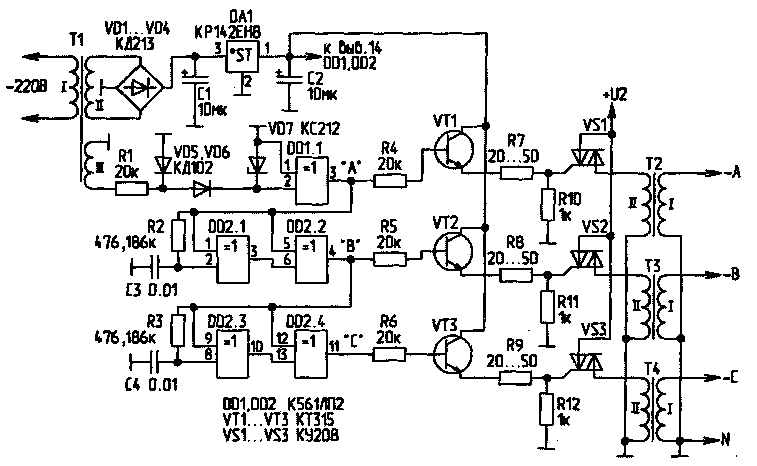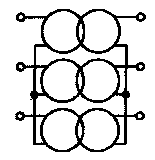Connection of three-phase consumers to a single-phase network. Encyclopedia of radio electronics and electrical engineering

Encyclopedia of radio electronics and electrical engineering / Power supply
 Comments on the article
Comments on the article
In amateur radio literature [1...5], the question of connecting a three-phase consumer to a single-phase network has been repeatedly raised. The authors of the articles point out the disadvantages of the described methods:
- loss of 50% of the nominal power;
- not all brands of electric motors start well when powered from a single-phase network;
- the need to use two containers (starting and working);
- stepwise adjustment of the capacity rating in different operating modes;
- the need to change the capacitance rating when the load on the shaft changes;
- at idle, the current flowing through the motor winding is 40% more than the nominal one;
- extra "bells and whistles" to automate the shutdown of the starting capacitor and when replacing paper capacitors with electrolytic ones.
I propose another option for connecting three-phase consumers to a single-phase network.
If you look at the three-phase voltage graph, you can see that each curve is shifted relative to the other by 1/3 of the period (Fig. 1).

Ris.1
The mains frequency is 50 Hz, therefore, the period T is 20 ms. It follows that 1/3 of the period is 6,666 ... ms. Let Ua in Fig. 1 be a single-phase sinusoidal voltage of 220 V, 50 Hz. Having passed Ua through the delay circuit for 6,666 ... ms, we obtain a voltage Uv shifted by 1/3 of the period, equal in amplitude and frequency to Ua. Having “passed” the voltage Uv through a similar delay circuit, we get the voltage Uс shifted by 1/3 of the period relative to the voltage Uv.
A schematic diagram of such a device is shown in Fig.2.

Fig.2 (click to enlarge)
The device consists of a power supply and a positive polarity pulse generator on the T1 transformer. The power supply includes the winding II of the transformer T1, the rectifier bridge VD1 ... VD4 and the stabilizer DA1. The pulse generator is assembled on the winding III of the transformer T1, the resistor R1 and the rectifier on the diodes VD5, VD6. The zener diode VD7 protects the inputs of the DD1.1 element from accidental overvoltage of more than 12 V. A rectangular pulse shaper is assembled on the DD1.1 element. You can also use the comparator, described in detail in [6]. At the output of the shaper DD1.1 there are rectangular pulses with a frequency of 50 Hz of positive polarity.
Suppose that these are voltage pulses Ua (Fig. 1). Pulses from the output "A" of the element DD1.1 are fed to the input of the delay circuit assembled on the elements DD2.1, DD2.2. R2, C3. At the output of the element DD2.2, pulses appear that are delayed by 1/3 of the period relative to pulses "A", i.e. "B" impulses. Pulses "B" are fed to the input of the second delay circuit on the elements DD2.3, DD2.4, R3, C4, at the output of which (element DD2.4) there are pulses corresponding to the voltage Uc in Fig. 1, shifted by 1/3 of the period relative to "Uv". Pulses "A", "B", "C", shifted relative to each other by 6,666 ... ms, arrive at the key stages VT1, VS 1; VT2, VS2 and VT3, VS3 respectively. From the outputs of the keys (triacs VS1 ... VS3), a pulsed voltage with a frequency of 50 Hz is supplied to the windings of transformers T2 ... T4. From the output windings of the transformers, we obtain sinusoidal voltages shifted by 1/3 of the period or by 120 ° one relative to the other, i.e. three phase voltage.
Details and circuit adjustment. The shaper of rectangular pulses can be made according to any of the known schemes. Instead of diodes VD1 ... VD4, you can use the KTs405 bridge. Triacs VS1 ... VS3 are replaced by thyristors KU202, because DC voltage is applied to their inputs. The time constant t of RC circuits R2, C3 and R3, C4 is calculated by the formula T=1,4RC. Taking the capacitance of the capacitors C3, C4 equal to 0,01 μF, we find the resistance of the resistors R2, R3, which is 476,186 k. In this case, the time constant t is 6,666604 ms, which is almost equal to a shift of 1/3 period. For a more accurate adjustment of m RC circuits, resistors R2, R3 consist of series-connected constant and trimmer resistors with a total value of about 510 k. The trimmer resistor adjusts m RC circuits, controlling the phase shift at the outputs of transformers T2 ... T4 with a phase meter, so that the shift phase was as close as possible to 120°.
When transforming a three-phase current, either three single-phase or special three-phase transformers with a core in the form of three shorted rods are used. The connection diagram of the individual transformers (Fig. 3) corresponds to the star/star connection. Such a connection is shown in Fig. 3 [7].

Ris.3
Transformer T 1 (Fig. 2) - factory. Winding voltages: II - up to 30 V (Umax.in DA1); III-12 V. T2 ... T4 - increasing. The input "+U2" is supplied with a nominal voltage, for which the windings T2 ... T4 are designed, i.e. 12 V at Uii=12 V, 24 V at Uii=24 V, etc. Transformers T2 ... T4 - ready for the corresponding currents and voltages or home-made.
Literature
- Three-phase electric motor in a single-phase network. - Radio amateur, 1992, No. 12, C.20.
- Smirnov K. On the operation of a three-phase electric motor in a single-phase network. - Radio amateur, 1993, No. 6, S. 27.
- Kukharenko A. Three-phase motor in a single-phase network. - Radio amateur, 1996, N2, p.28; 1996, No. 3, p.27.
- Novik A. Polar capacitor in the alternating current circuit. Radio amateur, 1996, No. 9. C.17.
- Egovkin V. Choice of diodes for starting oxide capacitors. - Radio amateur, 1997, No. 7, S.12.
- Ilyin A.G. AC voltage stabilizer. - Radio amateur, 1997, No. 8, C.25.
- Vorobyov A.V. Electrical engineering and electrical equipment of construction processes. - M.: Publishing house "ASV", 1995.
- Ginkin G.G. Handbook of radio engineering. - GEI, 1948.
Author: A. Ilyin, St. Petersburg; Publication: N. Bolshakov, rf.atnn.ru
 See other articles Section Power supply.
See other articles Section Power supply.
 Read and write useful comments on this article.
Read and write useful comments on this article.
<< Back
 Latest news of science and technology, new electronics:
Latest news of science and technology, new electronics:
Machine for thinning flowers in gardens
02.05.2024
In modern agriculture, technological progress is developing aimed at increasing the efficiency of plant care processes. The innovative Florix flower thinning machine was presented in Italy, designed to optimize the harvesting stage. This tool is equipped with mobile arms, allowing it to be easily adapted to the needs of the garden. The operator can adjust the speed of the thin wires by controlling them from the tractor cab using a joystick. This approach significantly increases the efficiency of the flower thinning process, providing the possibility of individual adjustment to the specific conditions of the garden, as well as the variety and type of fruit grown in it. After testing the Florix machine for two years on various types of fruit, the results were very encouraging. Farmers such as Filiberto Montanari, who has used a Florix machine for several years, have reported a significant reduction in the time and labor required to thin flowers.
... >>
Advanced Infrared Microscope
02.05.2024
Microscopes play an important role in scientific research, allowing scientists to delve into structures and processes invisible to the eye. However, various microscopy methods have their limitations, and among them was the limitation of resolution when using the infrared range. But the latest achievements of Japanese researchers from the University of Tokyo open up new prospects for studying the microworld. Scientists from the University of Tokyo have unveiled a new microscope that will revolutionize the capabilities of infrared microscopy. This advanced instrument allows you to see the internal structures of living bacteria with amazing clarity on the nanometer scale. Typically, mid-infrared microscopes are limited by low resolution, but the latest development from Japanese researchers overcomes these limitations. According to scientists, the developed microscope allows creating images with a resolution of up to 120 nanometers, which is 30 times higher than the resolution of traditional microscopes. ... >>
Air trap for insects
01.05.2024
Agriculture is one of the key sectors of the economy, and pest control is an integral part of this process. A team of scientists from the Indian Council of Agricultural Research-Central Potato Research Institute (ICAR-CPRI), Shimla, has come up with an innovative solution to this problem - a wind-powered insect air trap. This device addresses the shortcomings of traditional pest control methods by providing real-time insect population data. The trap is powered entirely by wind energy, making it an environmentally friendly solution that requires no power. Its unique design allows monitoring of both harmful and beneficial insects, providing a complete overview of the population in any agricultural area. “By assessing target pests at the right time, we can take necessary measures to control both pests and diseases,” says Kapil ... >>
 Random news from the Archive Random news from the Archive The camera does not need a lens
01.02.2014
Rambus specialists have developed a CMOS image sensor that allows you to make cameras without lenses. As stated, the development will significantly reduce the cost and reduce the size of digital cameras by eliminating the lens, which accounts for a significant part of the cost and size.
In short, the new structure allows the main functions of the camera to be realized only by the sensor and the signal processor. To do this, a CMOS type sensor is endowed with certain optical properties. Note that the theoretical part of the study has already been confirmed by practice.
It is expected that reducing the cost and size of digital cameras will significantly expand their distribution. In particular, it will be possible to produce and use disposable cameras.
The developers note that new cameras need a rather complex signal processing scheme. In some cases, for example, for real-time video processing, the performance of this scheme must be relatively high. However, Rambus believes there are a number of applications where the benefit of eliminating optical components outweighs this overhead. In addition, the company estimates that the annual rate of growth in the specific performance of signal processing circuits is 150%, which is incomparably higher than the indicator of optical components, equal to 5%.
|
 Other interesting news:
Other interesting news:
▪ VIPER26K regulators with built-in MOSFET 1050 V
▪ Cabbage harvested in space
▪ The Pain Relieving Power of Music
▪ All Optical Switch
▪ Accumulators of the third millennium
 News feed of science and technology, new electronics
News feed of science and technology, new electronics
 Interesting materials of the Free Technical Library:
Interesting materials of the Free Technical Library:
▪ section of the site Funny puzzles. Article selection
▪ article by Irvine Shaw. Famous aphorisms
▪ article Who was the first person to walk on the surface of the moon? Detailed answer
▪ article Electrician for the repair and maintenance of electrical equipment of gas stations. Standard instruction on labor protection
▪ article Scheme of the electrical equipment of the car VAZ-21213 (Niva). Encyclopedia of radio electronics and electrical engineering
▪ article Color corrector on the TDA4565 chip. Encyclopedia of radio electronics and electrical engineering
 Leave your comment on this article:
Leave your comment on this article:
 All languages of this page
All languages of this page
Home page | Library | Articles | Website map | Site Reviews

www.diagram.com.ua
2000-2024







 Arabic
Arabic Bengali
Bengali Chinese
Chinese English
English French
French German
German Hebrew
Hebrew Hindi
Hindi Italian
Italian Japanese
Japanese Korean
Korean Malay
Malay Polish
Polish Portuguese
Portuguese Spanish
Spanish Turkish
Turkish Ukrainian
Ukrainian Vietnamese
Vietnamese



 Leave your comment on this article:
Leave your comment on this article: